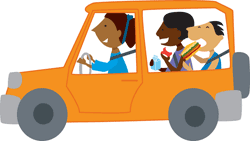We Can!® Community News Feature

Healthy Eating on the Go
Introduce your family to the idea of GO, SLOW, and WHOA foods to help them eat healthier
 Today's families are more on the go than ever, spending many hours each week in the car, making it seem hard to make time for your family to eat healthy, nutritious foods. Increased time spent in the car has led many families to eat on the go. According to the U.S. Department of Agriculture, 48 percent of the money spent on food in this country pays for meals eaten away from the home.
Today's families are more on the go than ever, spending many hours each week in the car, making it seem hard to make time for your family to eat healthy, nutritious foods. Increased time spent in the car has led many families to eat on the go. According to the U.S. Department of Agriculture, 48 percent of the money spent on food in this country pays for meals eaten away from the home.
During hectic days, families need energy to keep them going, but they often end up choosing more convenient foods that are high in fat, added sugar and calories.
This year, you can introduce your family to the idea of GO, SLOW and WHOA foods to help them eat healthier. GO foods are low in fat, sugar and calories and are "nutrient dense" (rich in vitamins and other nutrients). Try to avoid SLOW and WHOA foods that are higher in fat, added sugar and calories and that, often, offer fewer nutrients.
Whether you're off to a Saturday away game or driving your children to their weekly activities, use these tips for healthier eating:
- Pack GO foods ahead of time. If you have a busy day with your family planned including time in the car pack healthy snacks in a small cooler or tote bag before you leave. Consider water, fresh fruit or veggies, low-fat cheese sticks, whole-grain crackers or a low-sugar cereal portioned into baggies.
- Make healthy choices at fast-food restaurants. Sometimes, when you are traveling by car, fast food is the only option. Try making healthier choices such as sandwiches without cheese, salads with low-fat or fat-free dressing, replacing French fries with sliced fruit, and swapping fried meats for grilled options.
- Read the labels. Stopping at convenience stores for a snack can easily lead to unhealthy choices. Looking at the nutrition label can help you and your children make the best choice. Pick snacks or beverages that are low in calories and added sugar—some stores stock fat-free or low-fat yogurt, fruit or individually portioned trail mix. Try to remember that some prepackaged foods may look like a single serving but actually contain multiple servings.
For more ways to encourage physical activity, as well as eat right and reduce screen time, visit the We Can! (Ways to Enhance Children's Activity & Nutrition)® at http://wecan.nhlbi.nih.gov. Developed by the National Institutes of Health, We Can! provides parents, caregivers and communities with free tips, tools and guidance to help children ages 8–13 maintain a healthy weight by improving food choices, increasing physical activity and reducing screen time.










